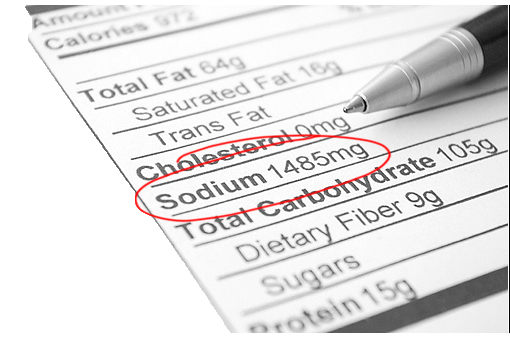
To lower your risk of heart disease and stroke, the American Heart Association recommends that you consume under 1500 milligrams of sodium per day. But how much do you really need? To put things into perspective, the National Academy of Sciences tells you that if you’re healthy your physiological need is just 250 milligrams- so under normal circumstances you simply don’t require that much sodium. Furthermore, according to dietician Jeff Novick, if 100% of your diet consists of fresh fruits and vegetables – assuming you’re eating a normal amount of calories – your intake of naturally occurring sodium would be 500 milligrams. After all, just one cup of spinach provides you with 79 mg of sodium, four ounces of celery gives you 115 mg, and less than five ounces of honeydew melon contains 30 mg. The fact is that sodium is naturally present in most foods and, unless you are suffering from a health issue, it is impossible for you to get too little of it. The problem is that you are probably getting too much without even realizing it. The average sodium intake in North America is 3000-5000 mg per day.
The Unconscious Addict.
Last week I consulted with a client who proudly informed me that she’s been “watching her sodium intake for years”. But, once I reviewed her food log, it turned out that she was consuming over 5000 milligrams per day! This wasn’t the first time that I had a client’s jaw drop to the floor in complete shock and dismay. So, how does this happen? How does someone who is watching her sodium intake still manage to consume over 3 times the maximum limit deemed safe? Are you also making this mistake? Here are some tips to help you transition from an unconscious sodium addict to a well informed consumer.
Tip #1: The Salt Shaker Isn’t To Blame.
Only about 10% of the sodium in your diet comes from the salt shaker and what you add while cooking at home. The biggest chunk of your sodium intake – close to 80% – comes from processed foods and restaurant meals. Like my client who, without realizing, was consuming over 5000 mg of sodium per day, you can throw the salt shaker away and still be unconsciously addicted to salt. For example, we all know that a pad Thai at Thai Express contains a whopping 2538 mg of sodium, but did you know that a serving of Campbell’s vegetable soup has 890 mg of sodium? And you thought vegetable soup was healthy! V8 100% vegetable juice, another horrible product, contains 920 mg of sodium for just 70 calories – and I’ve seen hospitals serve this to their patients. Two slices of popular brands of whole grain bread have about 400 mg of sodium. So, it is clear that reducing sodium intake has very little to do with the salt shaker, and more to do with your overall diet – and that’s even if you stay clear of cured meats, cheese, and junk food.
Tip #2: Never Trust The Front Label.
For my lecture on how to properly interpret food labels I ask my clients to bring me 5 products that they consume on a regular basis. My sodium addict brought in a jar of Organic Kalamata Olives, and as she handed it to me she proudly proclaimed “they are organic, I always buy organic”.
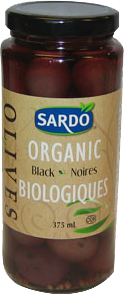
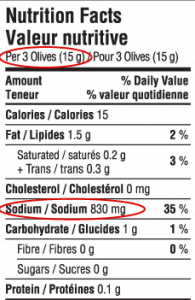
True enough, the first thing you would notice on the front label is the word “Organic” written in a large clear font. This product was obviously purchased at a health store where many unsuspecting health conscious individuals do their grocery shopping. My tip is ignore the front label (sorry to all the marketing experts out there) and quickly turn to the back where you will find the Nutrition Facts. I pointed to the Nutrition Facts to show my client that with every 3 olives she was ingesting 830 mg of sodium! She normally consumed anywhere from 6-10 olives per sitting which equates to 1720 – 2767 mg of sodium. In other words, if the only thing she ate the entire day were 10 of these olives she would be almost doubling the recommended limit for sodium. Health food stores do carry some good products and it is very important to buy organic, however, in order to make better choices you still have to read the Nutrition Facts and ignore the marketing on the front label.
Tip #3: The 1:1 Calorie/Sodium Rule.
Apply this rule whenever you are buying any product that has a label. Turn to the Nutrition Facts and look at how many calories there are per serving. Then scroll down to see how much sodium you are getting. The amount of sodium in milligrams should not exceed the amount of calories. For example, if a product contains 100 calories per serving the sodium content should be 100 mg or less. I like this rule because it’s simple and clients can begin applying it immediately.
Now, let’s say that you are consuming 2500 calories per day. If you follow the 1:1 ratio of calories to sodium you would still be ingesting 2500 mg of sodium. That’s too much. But then again, your diet should NOT consist primarily of packaged processed food. The most important point of this article is that you should always try to reduce the amount of processed foods that you consume. Your diet should mainly consist of fresh vegetables, whole grains and legumes, all of which naturally contain an ideal amount of sodium that your body requires to function optimally. You see, with very few exceptions, you don’t need to watch your sodium intake when you are eating unprocessed whole foods. But, when you have to buy packaged foods, or anything that comes with a label, do your best to adhere to the 1:1 sodium rule. For some products, such as soy sauce or canned olives, finding versions that pass the 1:1 test is impossible, but you can still find alternatives that aren’t too bad and dilute them when possible. The good news is that you will be able to find brands of many items that do pass the 1:1 test, and it’s up to you to grab the better product from the shelf.
So now it’s your turn. Let’s see you put the 1:1 rule into action: if you choose to buy crushed tomatoes instead of making your own pasta sauce from scratch, which of the following two products below would you choose?
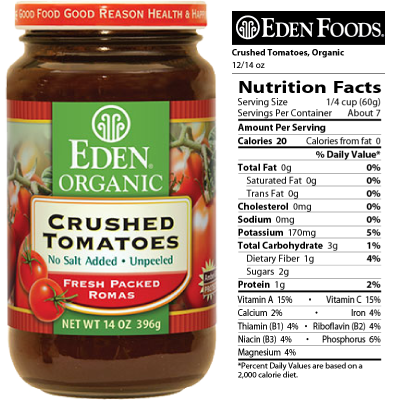
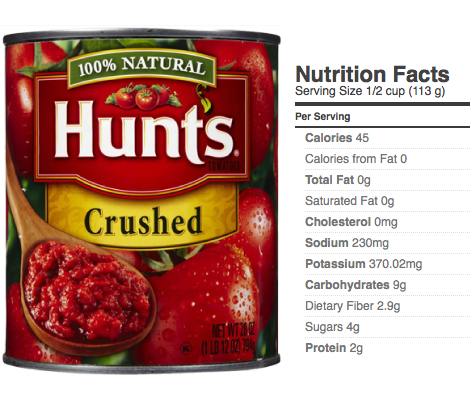
Sodium Isn’t The Only Problem.
Every few years the media begins to obsess with one nutrient just to keep your attention. It’s time to move away from such a reductionist approach to health and nutrition. Whether it’s fat, gluten, sugar, sodium, or any mineral or vitamin, no single nutrient on its own is ever as important as the effect of the sum of all the nutrients that you are consuming with every bite. Of course, consuming a high amount of sodium is bad and its effects are felt almost immediately, but sodium alone is not to blame. There is a larger picture to look at to ensure that you are supplying your body with what it needs to function optimally.
A poor overall diet, lacking in proper foods and high in harmful chemicals, is the reason that people today are prone to developing chronic diseases. Even health conscious individuals that know how to read food labels fall prey to health issues that are associated with choosing the wrong kinds of food. For example, my short video lecture, Exposing The Whole Grain Myth, shows you that even if you purchase whole grain breads or breakfast cereals that are low in sugar and sodium, there are other factors that you must consider if health is your main concern. When grains are not sprouted they maintain high amounts of anti-nutrients that lower your absorption of important minerals. Sprouting grains serves to magnify their nutritional content, activate enzymes, release anti-nutrients, and improve your digestion. Similar to my video exposing the truth about processed grains, my article on commercially sold “Almond Milks” teaches you about the dangers of synthetic nutrients that are added to your food without being properly labeled. And what about the canned crushed tomato example that I gave above – Is Eden’s product better than Hunts because it is lower in sodium? Actually, regardless of their sodium content, canned tomatoes are extremely acidic and should be generally avoided. Properly ripened fresh raw tomatoes are your best choice especially if you are suffering from acidity issues. And finally, the worst culprit of them all, our dependance on animal protein is the strongest and most consistent dietary factor linked with chronic disease- whether we add salt or not, and even if we always choose the leaner low-fat option.
The bottom line is that a diet rich in fresh, unprocessed, plant based whole foods is the best way to provide your body with the thousands of chemicals, including sodium, that it needs to sustain good health. And, as it seems nature intended, these nutrients are often naturally present in ideal ratios. So one day, when you improve your entire approach to eating well, you won’t have to read food labels anymore. But until then, watching your sodium intake is a good rule of thumb.
Marc Jaoude
Naturopath, Health Educator
Nutrition & Exercise Specialist

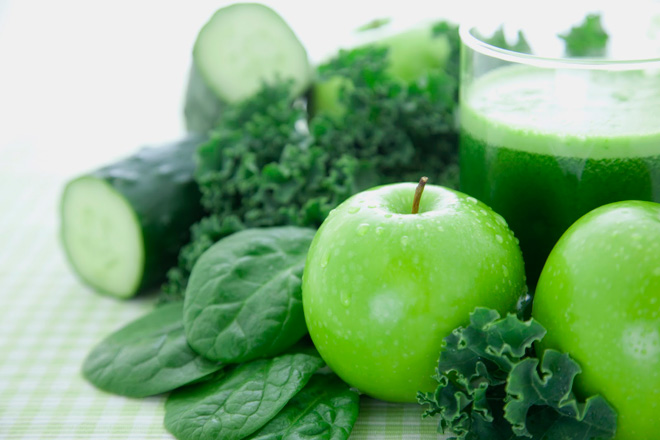
I hate all of these articles shaming sodium. They mislead people into believing sodium is bad for you. Some people don’t get enough sodium and have to increase their sodium intake to levels that are more than the RDA to benefit their health and still have trouble getting the RDA. People say sodium is bad for your heart health and causes high blood pressure but without the necessary amount of sodium the opposite of high blood pressure happens and disorders related to that happen. Plus if someone were to really listen to all of these sodium shaming articles and not get enough sodium then their sodium to potassium ratio would not be good and cause nervous system issues. The articles need to be about overall nutrition not just about one nutrient. Those kinds of articles would be of better benefit to the public because otherwise you have people who are listening to this and that fad nutrient or aspect of the food to avoid which leaves people just plain sick and miserable. They listen to the advice of what the supposed experts told them and all it gave them was illness. Focus on total nutrition and total body health which nutrients work together to promote certain benefits and educate people as to what nutrients are in fruits and vegetables and other wholesome foods and there will be better results and less toxicity or an inadequate intake of nutrients. I realize there’s already at least one really good website out there that does this but if you can point out if, because this website also includes processed foods, you could point out which vitamins in the processed foods, like cereals, are synthetic and why that’s bad for you then maybe people would start eating more fruits and vegetables and sprouting and eating healthier in general. You can get all your nutrients in one day by blending various fruits and vegetables and adding things like homemade peanut butter or homemade almond butter and oats and chia seeds along with milk and protein powder. You probably won’t get all the calories you need nor all the sodium and you’ll definitely get too much manganese, and too much Vitamin A depending on the fruits and vegetables you use, which makes this way too efficient at getting nutrients and not very effective for gaining weight but when you can’t eat real food what else can you do to survive. Anyways, all of this is just my opinion. I hope you didn’t take any offense.
Hello Rebecca,
I’m not sure if you read my article before commenting. I explicitly say that sodium is not the only problem, and that we need to be more concerned about consuming the right kinds of food as opposed to worrying about individual nutrients. However, as long we are still purchasing processed or prepared foods from the grocery store, the sodium rule I describe is helpful. The people at risk for not getting enough sodium are those who only consume low sodium processed foods, and nothing natural. All natural foods contain sodium. If you are on a good overall diet, as I write in this article, you don’t need to be concerned about your sodium intake. I appreciate your comment, and not only do I agree with several of your points but they are also included in my article- which leads me to believe that you did not read much further than the heading.
Actually, I read the full article, thank you very much. I understood exactly what you said. My point is this, and you’re right about the salt shaker not being the problem because no matter how much salt I add to my food I can never get enough. Even if you only eat fruits, vegetables, good fats like nuts, with or without the salt or nut butters you still may not get enough sodium. So I understand your point that people should stay away from processed foods because processed foods have a lot of sodium in them. However, you didn’t understand my point. My point is that for some people cutting all of this sodium out of their diet, all of the processed foods and going completely natural will still not give them the amount of sodium that they need. The fruits and vegetables have negligible amounts of sodium in them compared to other foods. I know because for months I was on a liquid/purified diet due to a disorder and I could only eat the things I mentioned in my previous post that were all natural. Everything I consumed for many months was all natural. I used a website to figure what nutrients were in each of the foods I was putting into my blender so I knew what nutrition I was getting. I made my own almond butter so I could put plenty of salt in it. You don’t realize that there are people who need more than the RDA of sodium and have to supplement their sodium needs by adding salt to things or drinking things like Gatorade, yes it’s processed but it has sodium, just to get the RDA but this is still not enough. That’s why I responded. to your article. It wasn’t that I only read the headline and didn’t read the article. I read the article but you don’t understand the people, and I realize they’re a minority, but the people who need more sodium. You don’t understand that some people even on an all natural diet, no processed foods what so ever can’t get their daily allotment of sodium without supplementing with things like Gatorade. I did a daily journal of all my nutrient and caloric intake. Neither did I get enough sodium nor did I get enough calories. I realize that the majority of the people in this country need less sodium because they don’t realize what they’re eating. However, there are a lot of people who know exactly what they’re eating. I told you to talk about total nutrition. It’s good you talked about cholesterol in another article. However, you could have done better. You talked about cholesterol as a whole and didn’t differentiate between the cholesterol thus shaming cholesterol which is bad because cholesterol as a whole is not bad for you. Cholesterol is necessary for the body to function. You could education the people better by telling not just to eat a low fat plant based diet because that’s also fat shaming and not all fat is bad for you. Some fats are good for you and fat is essential to our health. If you had said eating plant based fats instead of low fat then that would have been better. I had about 80g of plant based fats, along with the fat in the whole milk, every day on my liquid/pureed diet and when my doctor checked my lipid levels she told me they were the best she had ever seen. Now I’m not advocating anyone go on a liquid/pureed diet because it was miserable. I did this because I couldn’t eat real food. My point is that with the level of fat that I consumed everyday, if what you said in your cholesterol article about a low fat plant diet was best for low cholesterol then I should have had higher cholesterol, not because it wasn’t plant based but because it wasn’t low fat. So now it’s not just sodium shaming you’re doing, it’s not properly educating the people about cholesterol. I don’t mean about LDL and HDL. I mean about nutrition. Be specific about what foods can lower LDL and raise HDL and make the ratio of cholesterol/ non HDL appropriate. But be responsible about it because it may start fads. For example, the kale sensation. Kale is described as a superfood but if you eat too much of it you may become Vitamin A toxic so if people are aware that there are also limitations on how much of a food, even if it’s healthy, then that is better at educating the people. Instead of shaming ingredients, experts should be informing about whole foods, the benefits, the nutrients, the limitations and what exactly they do for our health. It’s extremely important to inform the people about the nutrients they’re eating but not in solitude. If the food combined with another food becomes even better for our health then mention that as well. Or conversely, if a food has a nutrient that if paired with another food or a couple of other foods could lead to toxicity of a nutrient and damaging for the health, for example how much manganese is in a full bowl of oats and then if you add a fruit like raspberries or if you’d prefer pineapple? That’s a lot of manganese and that could have bad effects. So mention that as well like the health effects and what to look out for. Certain people in our country know what nutrients are in their food and certain people don’t but I’d be willing to bet that most of them even if they do know what nutrients are in their food, or even if they look it up, don’t know what harmful or beneficial effects might happen when foods are combined and since your website has the word nutrition in the url, maybe you should focus on this instead of shaming certain things like fat and sodium and not properly educating people on cholesterol. I just don’t like it when the health community and nutritionists talk about one ingredient as if it’s terrible for you when really moderation about all of these ingredients is the key unless a specific person has trouble getting enough of certain ingredients or a certain person is allergic to a certain food.. I agree processed foods aren’t the best but even processed foods once in awhile won’t kill you.
Again, this is just my opinion, not meant to offend.
P.S. The first time I read your article it did make me miss being able to eat olives because of all the sodium in them. It’s also difficult for me to share a meal with my brother-in-law because he needs low sodium due to his kidneys and I need high sodium due to my heart.
Peace be unto you.
How come you did not mention about the Celtic Sea Salt? It is much nutritious with about 84 traces of minerals than any other table salts. It is recommended to use 1/4 of the Celtic Sea Salt in one liter of water daily.
Thank you for your question regarding Celtic sea salt. Sea salt, just like table salt, is mainly sodium chloride (NaCl). And sodium chloride, regardless of where it is derived, will contract your arteries.
However, many people unfortunately believe that sea salt is lower in sodium. One tsp of table salt = 2200 mg of sodium, while one tsp of sea salt = about 2000 mg. So yes, sea salt does have slightly less sodium, but the difference is negligible.
Let’s break it down further: We are told that sea salt contains more minerals. This is true, but to what extent? The trace levels of magnesium, potassium, calcium and other nutrients in sea salt are insignificant. For example, in order to get any significant amount of calcium from sea salt you would need to consume over 30,000 mg of sodium! I don’t think anyone will want to do that. I will mention one interesting study, “Effects of Chronic Excess Salt Feeding, Enhanced Hypertensogenic Effect of Sea Salt Over Sodium Chloride”, published long ago that concluded that sea salt may even be more effective than just sodium chloride at producing hypertension. Bottom line, there isn’t much difference between the two. Celtic sea salt is 84% NaCl, partially refined or mined sea salt is 98% NaCl, and refined table salt is 97.5% NaCl.
The best source of sodium, as well as other minerals, are plants. Minerals from plants are what we call organic minerals and they are better absorbed by the human body. A plant, through its roots, takes inorganic minerals from the soil and then synthesizes them into the form that our body needs and can absorb. Green juices are a tremendous way to get all of the vital nutrients, including minerals like sodium, that the body needs in a highly absorbable form. For example, sunflower green juice contains virtually every nutrient – including all the essential amino acids as well as trace minerals – that the human body needs. So if trace nutrients are what you are concerned about there are better ways to attain them than by intentionally adding sea salt (84-98% sodium chloride) to your diet.
The take home points are that excess sodium is to be avoided, and the best sources of minerals are plants. However, I do use and prefer sea salt to flavour my food because it is less processed- so there are certainly some advantages to sea salt. In fact, the best use for sea salts are for talking baths- many benefits there. The problem, however, is with the marketing of sea salt that leads people to orally ingest too much of it.